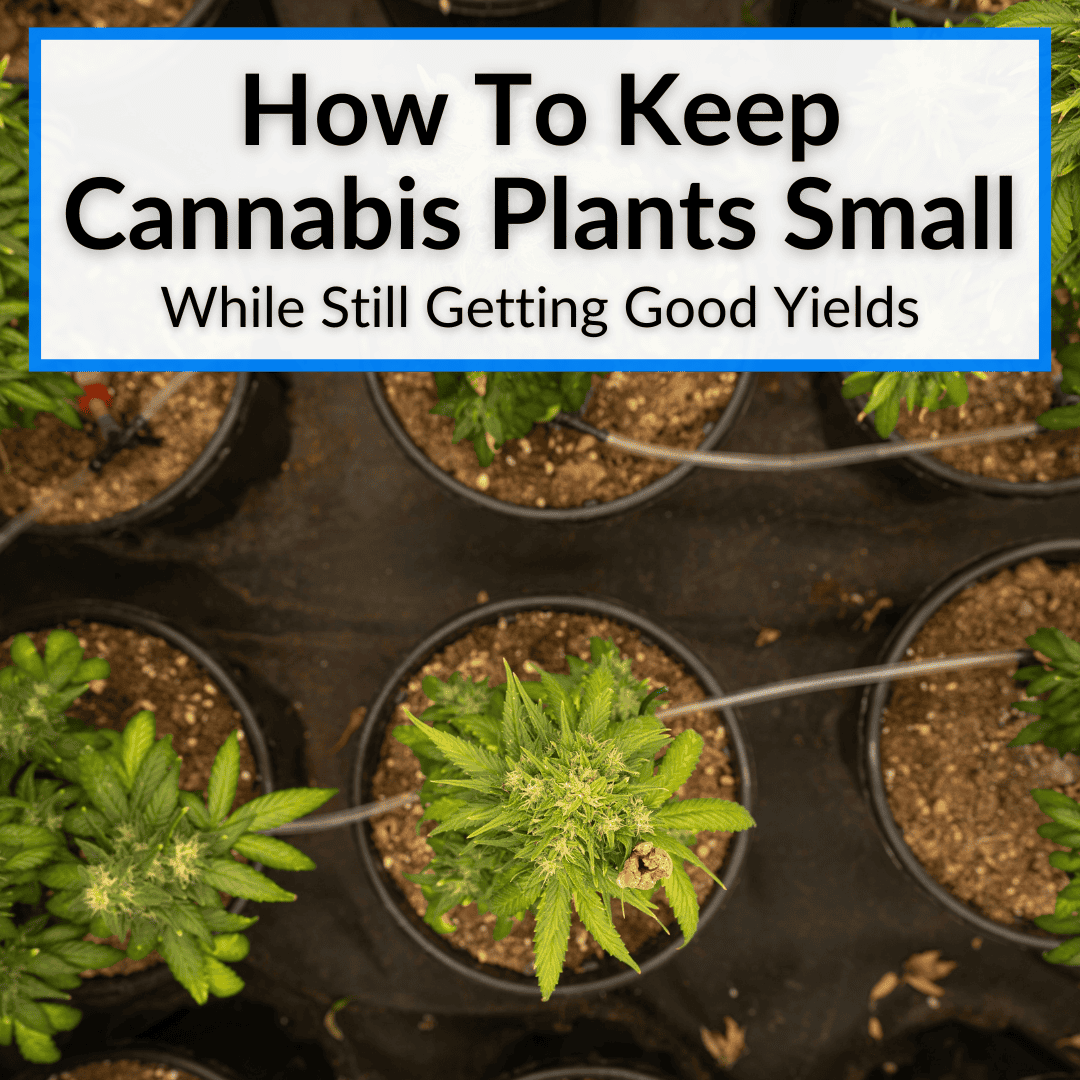 Most information out there tells you how to grow bigger plants.
Most information out there tells you how to grow bigger plants.
That’s true of my website, too.
But not everyone has the space for large plants.
Or even medium-sized ones.
Today I’m going to show you how to keep cannabis plants small, so you can grow weed even if you have very little space available.
There are a number of things you can do to keep your plants from growing large and we are going to cover all of them.
Contents
Choose The Right Strain For Small Grow Spaces
Some strains grow much bigger than others. The first step to growing smaller plants is to choose a strain that tends to stay on the smaller side.
Indica Vs Sativa: Differences In Growth Patterns
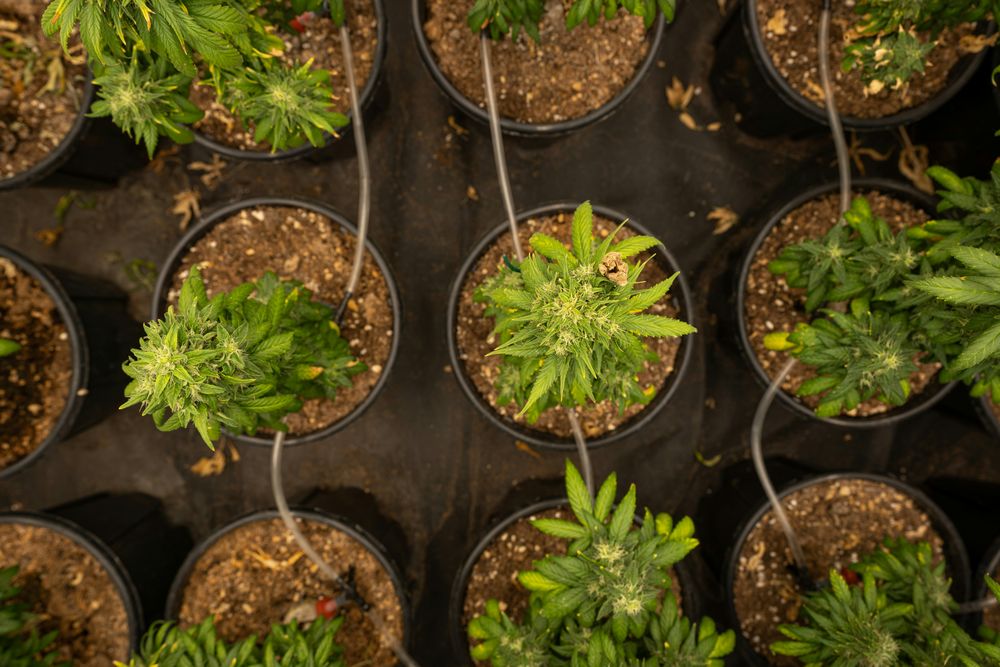
Understanding the basic differences between Indica and Sativa plants can help you when choosing which strains are best for growing in limited spaces.
- Indica strains are typically shorter, bushier plants with wider leaves. They tend to grow more vertically than horizontally, making them a better fit for smaller grow areas.
- Sativa strains, on the other hand, are known for their tall, lanky structure with long, narrow leaves. These plants can quickly outgrow small spaces if not carefully managed.
While it’s possible to grow Sativas in small areas with careful training, Indicas are generally a better starting point for beginners with limited space.
Strains Known For Compact Growth
When selecting a strain for your small grow, look for varieties specifically bred for their compact size. These strains are optimized to thrive in confined spaces without sacrificing yield.
- Research: Spend time researching strains known for their short stature and high yield potential.
- Breeders: Many seed banks offer strains specifically designed for small-space cultivation.
- Grower communities: Connect with other growers to get firsthand recommendations on compact strains.
Autoflowering Strains And Their Benefits For Small Spaces
Autoflowering strains are a fantastic option for small-space growers. Unlike photoperiod strains, which rely on specific light cycles to flower, autoflowers begin flowering based on their age, not light exposure.
- Compact size: Autoflowers tend to be shorter and bushier than many photoperiod strains.
- Faster lifecycle: With shorter grow times, you can fit more grow cycles into a year.
- Discrete: Their smaller size can make them easier to conceal in tight spaces.
Keep in mind that, while autoflowers offer advantages, they generally do not produce the same yields as carefully managed photoperiod strains. But there are some autoflower strains that deliver higher yields.
Start With The Right Equipment
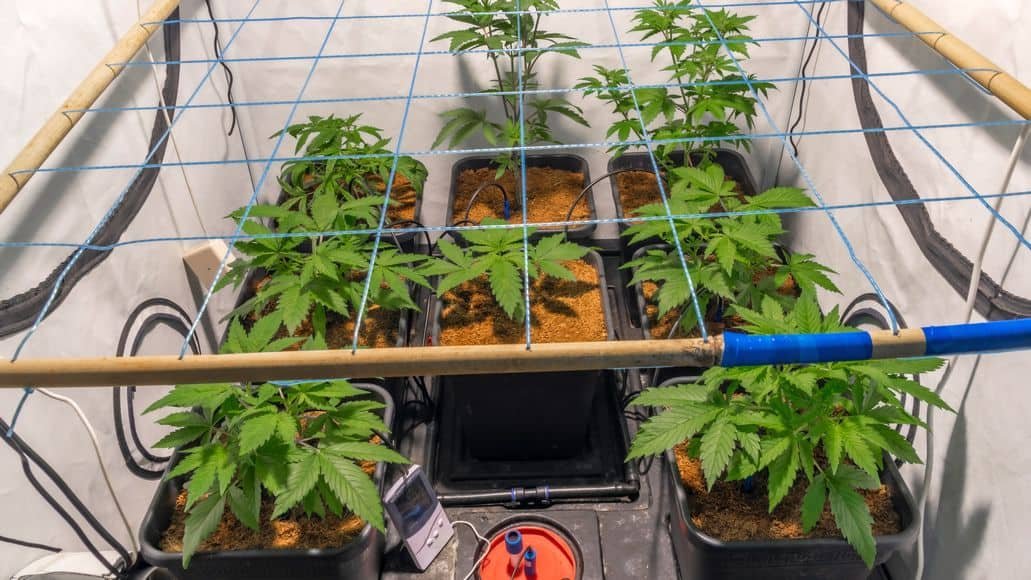
Choosing the right equipment is important for a small grow. This means lighting that is not too powerful and a small tent or grow box that fits into the space you have available.
Importance Of A Suitable Grow Tent Or Grow Box
Your grow space is the foundation for your cannabis garden. A well-chosen grow tent or grow box provides a controlled environment essential for optimal plant growth.
- Size matters: Select a tent or box that fits your available space without feeling cramped. Consider the expected size of your mature plants and the necessary equipment. Here are the best small grow tents on the market.
- Lightproof: Ensure that it’s completely lightproof to help you maintain the ideal light cycle for your chosen plants.
- Ventilation: Look for models with adequate ventilation ports for proper airflow.
Choose Appropriate Lighting (LED Vs CFL)
Selecting the right lighting is crucial for your plants’ health and yield.
- LED lights: Known for energy efficiency and longevity, LED lights offer excellent light penetration and less heat output, making them ideal for small spaces.
- CFL lights: While less efficient than LEDs, CFLs are more affordable. However, they generate more heat, which could cause issues in a tighter grow space.
Consider your budget, available space, and desired yield when choosing between LED and CFL lights.
Use Training Techniques To Control Plant Size
Training techniques are essential for managing plant size and maximizing yield in small grow spaces. Here are some effective methods:
Topping
Topping involves cutting the main stem of a plant to encourage lateral growth. This creates a bushier plant with multiple main cola sites, potentially increasing yield.
How to top cannabis plants correctly:
- Choose a healthy plant with several nodes.
- Use sharp, clean pruning shears to cut the main stem just above the desired node.
- Monitor the plant closely for new growth.
Fimming
Fimming is similar to topping but involves removing a smaller portion of the stem. This encourages more branching than topping, resulting in a fuller plant.
Step-by-step guide to fimming:
- Identify a healthy growth tip.
- Pinch off the topmost part of the growth tip, leaving a small amount of stem.
- Multiple growth points will emerge from the cut area.
Low-Stress Training (LST)
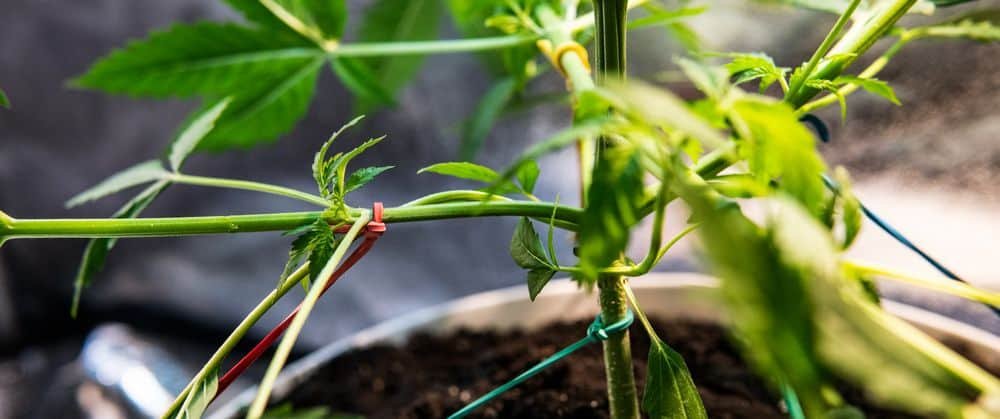
LST involves carefully bending and manipulating plant branches to control growth direction. This improves light penetration, increases bud sites, and helps manage plant height.
How to apply LST effectively:
- Start when plants are young and pliable.
- Gently bend branches and secure them in the desired position using plant ties or clips.
- Avoid excessive bending, as it can damage the plant.
Screen Of Green (ScrOG)
ScrOG involves using a screen to flatten the plant canopy and maximize grow space. This creates a uniform canopy, improves light penetration, and increases yield.
Setting up and maintaining a ScrOG:
- Place a screen above the plants.
- As plants grow, weave branches through the screen to create a flat canopy.
- Regularly adjust branches to maintain even distribution.
Pro Tip: Practice makes perfect when it comes to training techniques. Start with a few plants to experiment and find the methods that work best for you and your grow space.
Pruning And Defoliation
Pruning and defoliation are advanced techniques that can help you manage plant size and improve light penetration in your small grow space. However, you should approach these practices with caution to avoid stressing your plants.
Importance Of Pruning For Size Control
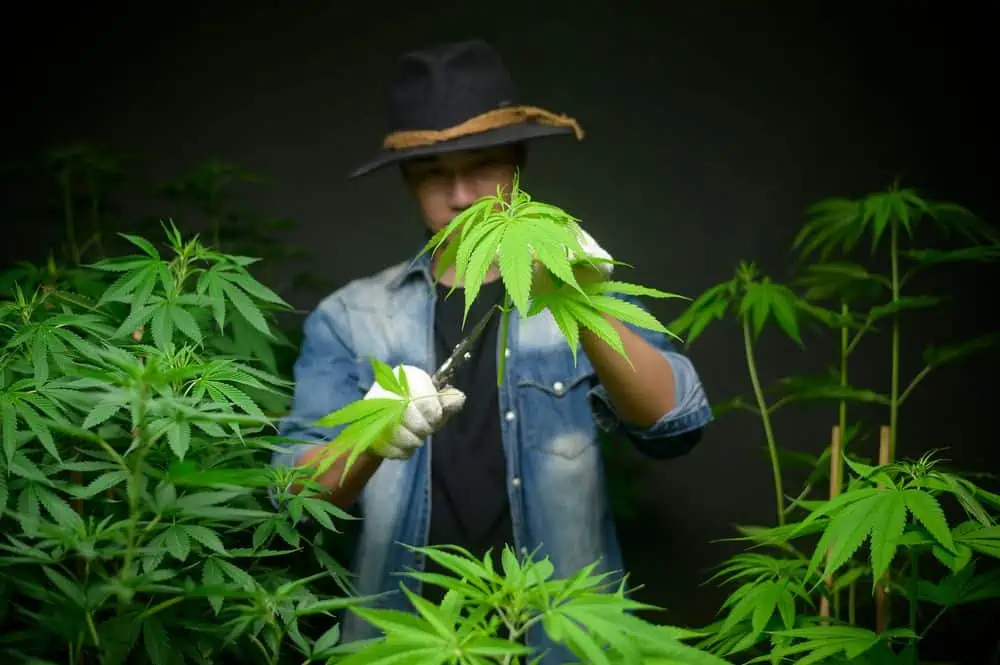
Pruning involves removing entire branches or stems. While it’s not typically necessary for small-space grows due to other size control techniques, it can be useful in specific situations:
- Removing dead or diseased branches: Promotes plant health.
- Controlling unruly growth: Can help redirect energy to desired areas.
How To Prune Without Stressing The Plant
If you decide to prune, follow these guidelines:
- Use clean, sharp tools: This will help prevent the spread of diseases.
- Make clean cuts: Avoid ragged edges that can invite infection.
- Prune sparingly: Remove only what’s necessary.
- Monitor for stress: Watch for signs of stress after pruning, such as wilting or yellowing leaves.
Defoliation Techniques To Manage Growth And Light Penetration
Defoliation involves removing individual leaves. It’s a more common practice in small-space grows. It improves airflow, light penetration, and bud development.
Techniques:
- Lower leaf removal: Remove large fan leaves shading lower bud sites.
- Interior leaf removal: Opens up the plant’s interior for better light distribution.
- Sugar leaf removal: Remove small, nutrient-poor leaves near bud sites.
Defoliation is often performed during the flowering stage, but the frequency and intensity depend on the plant’s growth and your specific grow environment.
Pro Tip: Less is often more when it comes to defoliation. Start conservatively and observe your plants’ response. Excessive defoliation can shock the plant and hinder growth.
How To Keep Cannabis Plants Small: Final Thoughts
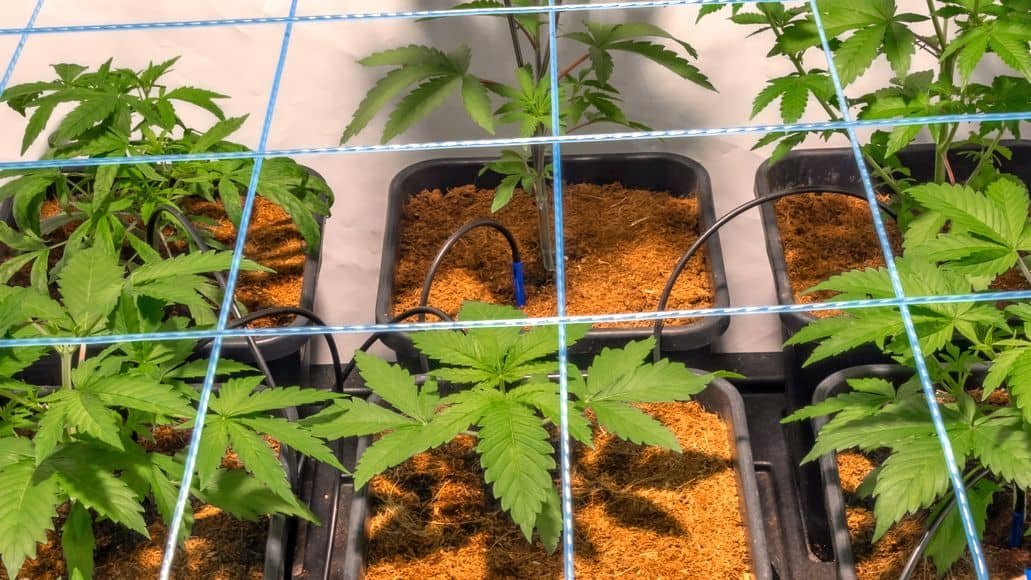
Growing cannabis in small spaces presents unique challenges. But with the right approach, it’s entirely possible to cultivate healthy, high-yielding plants in compact areas.
By carefully selecting appropriate strains, and using space-efficient equipment and employing strategic growing techniques, you can maximize your limited grow space without compromising on quality or yield. Especially if you choose a high-yielding cannabis strain that also tends to stay smaller.
Remember that successful small-space cannabis cultivation requires a combination of planning, patience, and adaptability. As you gain experience, you’ll develop a better understanding of what works best for your specific setup and preferences. Don’t be afraid to experiment with different methods and strains to find the perfect balance for your small-space grow.
With dedication and the right approach, you can turn even the tiniest grow space into a thriving cannabis garden. When it comes to cultivation, size isn’t everything. Happy growing!
Leave a Reply